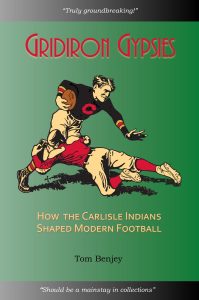Description
 ISBN 978-1-936161-06-5, 384 pages, softcover.
ISBN 978-1-936161-06-5, 384 pages, softcover.
After pleading with Superintendent Richard Henry Pratt to be allowed to play football against other schools, the small complement of students old enough competed against college men from coast to coast. Some had never seen a real football before and most were learning English. Located in a small town in Southcentral Pennsylvania, they traveled considerable distances to play all their important games on the road, but still won most of them. Soon, Carlisle players became known nationwide and more teams than they could schedule requested games. Large crowds turned out to see and support them. Their games were covered as much nationally as were the large universities. After hiring Pop Warner as their coach, they were a phenomenon. Carlisle players made All-America lists and seven have been inducted into the College Football Hall of Fame. These include Jim Thorpe, James Johnson, Gus Welch, Ed Rogers, Al Exendine, Joe Guyon and Lone Star Dietz.







tuxedo –
Midwest Book Review
Diane Donovan, Senior Reviewer
Gridiron Gypsies: The Complete History of the Carlisle Indian School Football Team is a study
of Carlisle’s team that begins in the late 1800s and delves into tradition and development in the
team to 1918, when it ended.
Much research into archival history, politics and social issues, and football went into Gridiron
Gypsies to create a much fuller-faceted flavor than what readers might anticipate from the
subject of football.
Indeed, it would be a shame to relegate Gridiron Gypsies to sports collections alone, or limit its
audience to sports history enthusiasts, because its accompanying insights into a small town
Pennsylvania school whose football team become known nationwide against all odds offers rare
glimpses into the politics of the sport.
It’s especially notable because the only other study of Carlisle’s extraordinary achievements was
made in the 1950s, prior to the advent of modern research tools.
School founder Richard Henry Pratt well knew the popular 1890s admonition “The only good
Indian is a dead Indian.” One would think that his background as a cavalry officer in the Indian
wars would have led him to support this idea, but Pratt was convinced that Indians could be
educated, established a school (Carlisle) for them, and fostered a liberal and far-sighted attitude
towards their place in white society that helped belay some of the prejudice against them: “In
great demand, the school’s popular band marched in several inaugural parades and played at
world fairs and other major events to show the general populace what Indians could do if given
the chances whites had. So, even though he abhorred the violence in the game, it was totally in
character for him to demand that, if Carlisle boys were to play football, they must soon play and
beat the best college elevens.”
As Gridiron Gypsies evolves, readers learn about the making of the school and its famous team,
and will find the history of both to be fascinating and thought-provoking.
Lively descriptions of team developments, major players and leaders, changing times and
challenges, and the politics governing the Indian School and its competitive abilities reveal
stories that ideally will see the light of classroom discussions.
If there was ever a book that should be a mainstay in collections strong in Native American
history, culture, and issues, or early civil rights efforts, it should be Gridiron Gypsies. The story
is about far more than sports, tackling the subject of integration and Native American rights in an
era when most would rather have killed than educate them.
tuxedo –
Booklife
Benjey reveals a fascinating, little-known slice of American history with this exhaustive examination of the football team at the Carlisle Indian School, a federally funded Pennsylvania boarding school for Native Americans that opened in 1879—and, before its closure in 1918, shocked the nation with its sports teams’ athleticism and competitive spirit. Those qualities are exemplified by the football program’s most famous alumnus, Jim Thorpe, a three-time All-American at Carlisle. Benjey tells the story of Carlisle’s football team, the “Indians,” season by season, drawing from press accounts and painting it all with a sportswriter’s sense of drama and color, while also explicating controversies and challenges the program faced, the intentions of its founders, and the stories of its participants.
As the title suggests, this work is written in the spirit of the times it surveys. Benjey’s use of “Indians” throughout (not just as a team name) reflects the tenor of the century-old press accounts that he draws on, which tend to sound like this: “Hoodwinked and hypnotized by the native trickery and masterful strategy of the aborigines … St. Louis University went down to an ignominious defeat.” The accounts of games and seasons are engaging and exciting, bursting with fascinating revelations, like Carlisle losing to Harvard 12 to 11 in the last-ever game at the original Soldiers Field, as Benjey charts the team’s growth from underdogs to powerhouse.
Benjey’s focus is on the games themselves, two decades’ worth recounted with vigor and attention to the history of college football and Carlisle itself. Especially interesting is America’s response to Carlisle’s success and the question of what a Carlisle education offered its students—and whether and how they benefited afterwards. Abundant photos, newspaper cartoons, and other well-selected visual documentation fill out the story, both celebrating these athletes and offering an illuminating (and sometimes upsetting) glimpse of bygone attitudes.